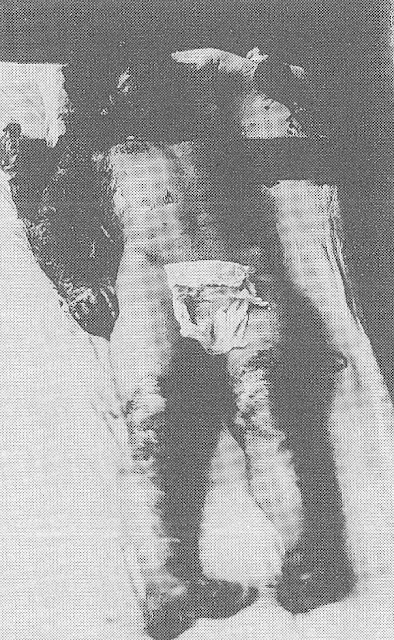The Nagasaki atomic bomb was dropped and exploded at 11:02 a.m. on August 9, 1945, and a 22-year-old female worker was exposed to the bomb. About 11 days after the bombing, she suffered from severe atomic bomb sickness and was escorted to the Omura Naval Hospital in Omura City, Nagasaki Prefecture, where she was hospitalized on August 20. He was admitted to the 12th Hospital and diagnosed with facial burns, left and right upper extremity burns, left and right knee joint burns, and left and right leg back burns. He had second-degree burns on his face, both upper limbs, both knees, and the backs of both feet. The entire surface of the burns was covered with black colored crusts. Pus flowed out from most of the wounds. There was a foul smell of pus in the air.
Upon admission, the patient was immediately given a subcutaneous injection of 500CC of tetanus serum. This was followed by daily intravenous injections of 200 ml of 25% dextrose with vitamins B and C. His general condition became debilitated, and his white blood cell count decreased to about 4,700 cells/mmli on September 8. No medical records of his subsequent course were noted. He was presumed to have died of A-bomb disease in the near future.
She was exposed to gamma rays of radioactivity released by the explosion of the atomic bomb, which destroyed the cells of his body. Whenever a person received a burn injury, he or she was exposed to gamma radiation. It also induced A-bomb disease, which caused the blood to be digested, resulting in hemorrhage, immune deficiency, bloody stools, and early death. Even young women began to look old and their hair fell off. The devastation and photographs of some of the survivors were recorded as much as possible.
After the outbreak of the Sino-Japanese War, a large naval air force was newly established in Omura City, Nagasaki Prefecture. It became a base for the mass production of fighter planes and suicide missions. At the outbreak of the Pacific War, a new naval hospital was established. On August 9, 1945, at around 3:00 p.m., we received a notice from the police that a large number of casualties had occurred in Nagasaki City. A rescue team was dispatched immediately. At around 5:00 p.m., Omura City informed us that the number of casualties in Nagasaki City was countless and requested that we take about 1,000 people to the Omura Naval Hospital along the railroad line. The severely exposed were escorted from Urakami in Nagasaki City to Omura Station by a separate train. After arriving at Omura Station around 8:00 p.m., they were transported to the hospital by fire engines and other vehicles. As many as 758 A-bomb survivors were admitted at one time. In addition, severely exposed survivors from relief stations in Nagasaki Prefecture were escorted one after another to the Omura Naval Hospital.




